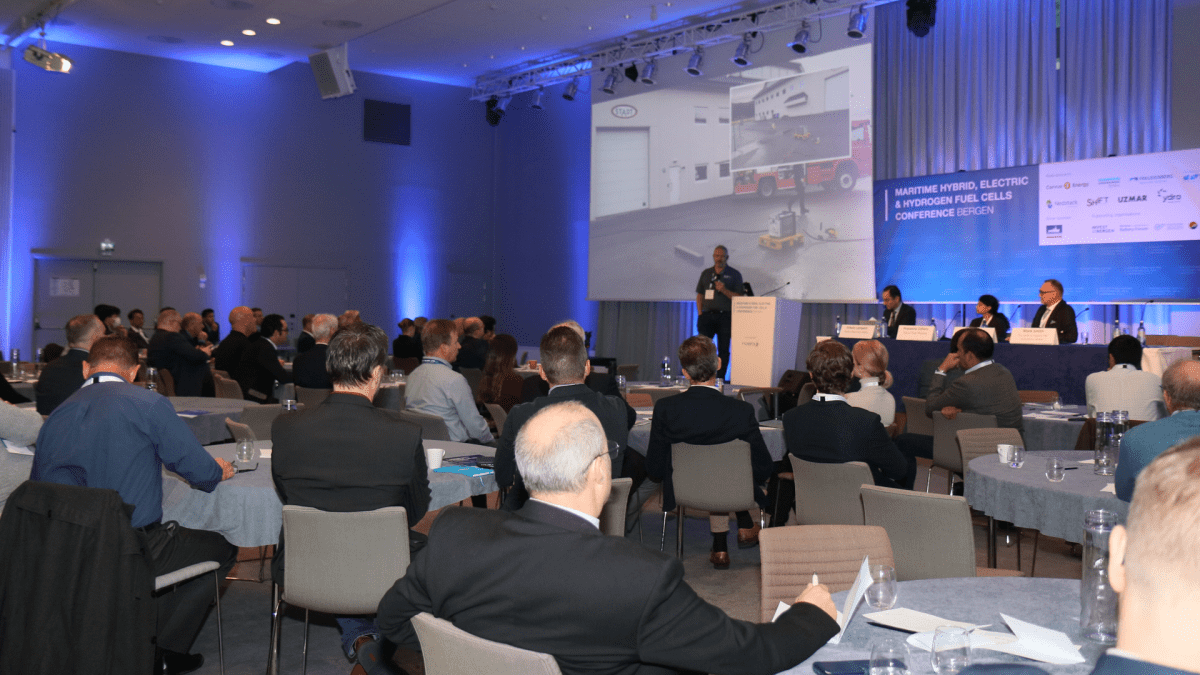Modularised and containerised batteries provide operators with solutions to decarbonise propulsion in ports, at sea and within inland waterways
Shift Clean Energy chief executive Brent Perry told Riviera Maritime Media multiple projects are underway involving the company’s batteries and onshore charging stations.
At Riviera’s annual Maritime Hybrid, Electric & Hydrogen Fuel Cells Conference in Bergen, Norway, he helped demonstrate how destroying one battery cell will not impact neighbouring cells in a package on a ship.
Colleagues and engineers from system integrator Stadt hammered a nail into a battery cell to show how this causes a brief fire and exhaust gases, but in a water-cooled pack, the other battery cells are unaffected.
Shift Clean Energy vice president for energy solutions Sietse Nap explained how battery modules in containers can provide sufficient power for ships on inland waterways and coastal trade routes. He said the PwrSwap swappable energy container service “improves efficiency in electrifying vessels.”
Vessel owners do not need to invest in energy storage on their vessels, but can swap containers of batteries during voyages and along routes.
“It is a pay-as-you-go service with vessel owners paying US$/kWh of energy used,” explained Mr Nap.
Corvus Energy chief executive Geir Bjørkeli said the maritime industry needs to collaborate with battery manufacturers, ship designers, shipyards and innovators to produce the zero-emissions ships of the future. He said technology innovations will enable owners to consider different business models and make informed bets on solutions.
“We are looking at energy-as-a-service as there are a lot of things we can do in the future,” said Mr Bjørkeli.
Corvus Energy senior vice president for management of commercial products Kjetil Dent Tranberg explained how the company’s next generation of Dolphin and Blue Whale energy storage solutions were modulised for future electrification projects.
“Batteries have become the standard for more and more vessel types, volumes are increasing and we needed to rethink design to adapt to a more dynamic and modularised technology development,” said Mr Tranberg.
In 2018, Corvus Energy started a project to develop the next-generation Dolphin and Blue Whale energy storage systems for maritime applications.
“The process has focused on cost efficiency, scalability and safety as well as flexibility and sustainability,” said Mr Tranberg.
These modular solutions will “revolutionise installations” and enable vessel owners and battery manufacturers to “adapt to new and better cell chemistries that become available.”
Future Proof Shipping is already investing in zero-emissions shipping. It has fuel cells and hydrogen on one inland waterway vessel, said director of corporate strategy Prasanna Colluru.
She said the challenges with further green vessels are “aligning business objectives with zero-emissions aspirations” and selecting which fuel or technology to invest in.
Future investment decisions will be influenced by total cost of ownership and vessel lifetimes. “We need to recognise the benefit of taking action early,” said Ms Colluru.
Over the next 5-10 years, Future Proof Shipping aims to build a fleet of 10 zero-emissions inland and shortsea vessels based on long-term time charter contracts to operators, logistics service providers and cargo /shippers.
“Our first zero-emissions vessel is sailing on hydrogen in 2022, and the next two are already in the design phase,” said Ms Colluru.






